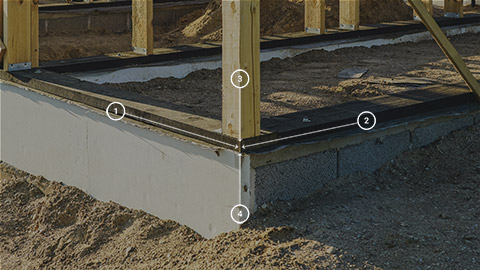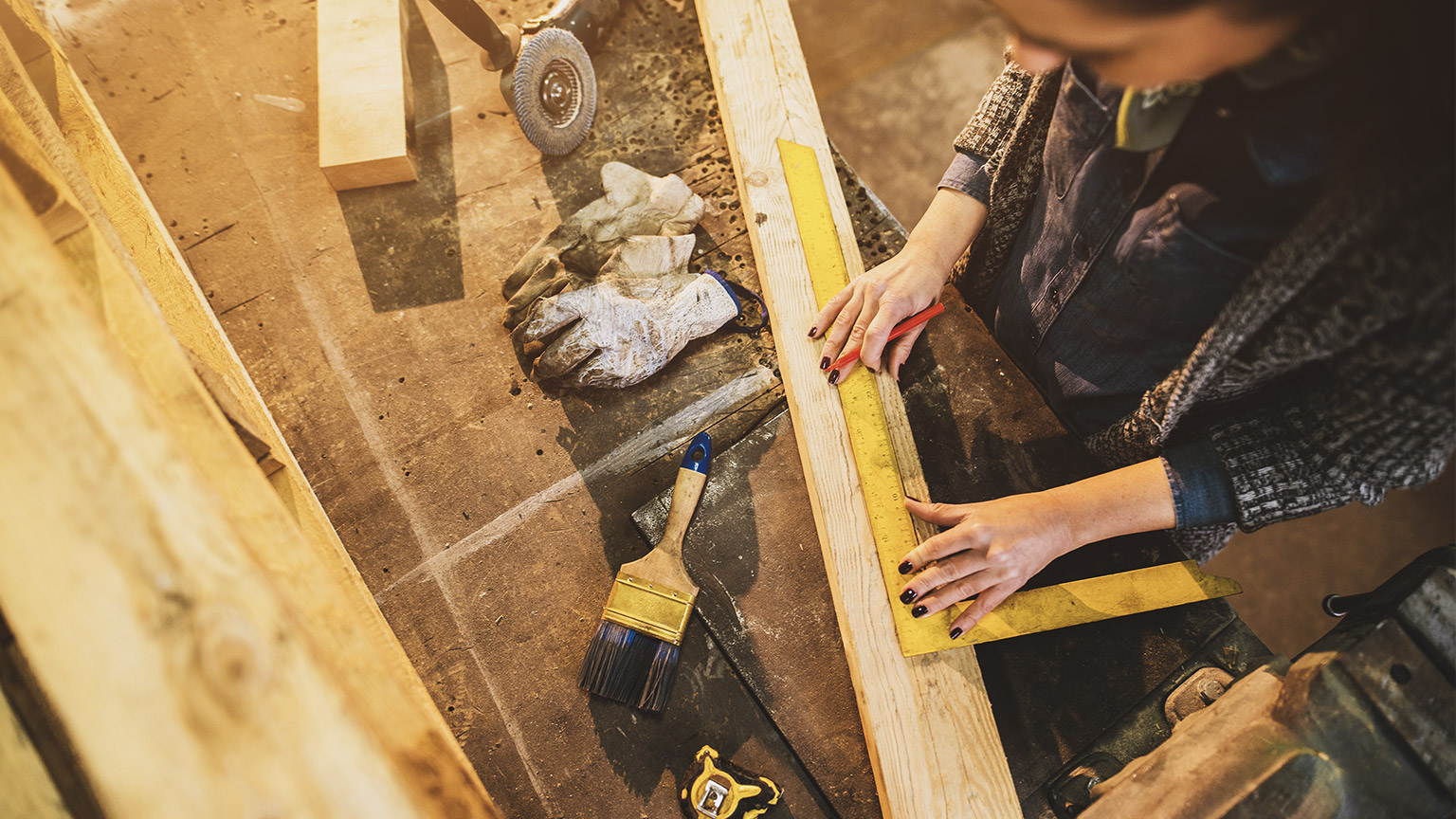So much of what you do throughout your construction career will rely on your ability to take accurate measurements. Whether it’s the detail in your finishes, your efficiency, the amount of waste you generate or your accuracy when ordering materials, it can all come back to the quality of your measurements.
You will take measurements on-site and from plans and drawings. You will also take a variety of measurements using a variety of tools. For this module, we are going to concentrate on linear measurements.
What are linear measurements?
Linear measurement is the distance in a straight line between two points. In construction, you will take a range of linear measurements. Most commonly, length, width, height, and depth.

- Length: The length is the measurement taken from one end of an object to the other end.
- Width: The width is the measurement taken from one side of an object to another.
- Height: The height is the measurement taken from the top to the base.
- Depth: The depth is the measurement taken from the surface of an area to the bottom.
Scenario
Imagine you are scoping an area for an in-ground swimming pool. First, you will need to decide on how long the swimming pool needs to be. You will then need to determine the width and length of the pool and whether it can fit into space. You would then need to consider how deep the pool needs to determine how much excavation is required. Finally, consider the height of the fence that needs to be erected around the pool. In this case, it would need to be carefully researched as rules surround the height of fences for pool areas.
Calculate the amount of soil (m3) that needs to be excavated based on the pool size below.
Do not allow for bulking of soil.
- Length 15m
- Width 4m
- Depth 1.5m
In Australia, the metric system of measurement is used. While you will often hear the imperial system, measurements referred to (most often feet and inches), you should make it a habit only to use metric measurements.
In building and construction, the most commonly used measurement is millimetres (mm). However, metres is also used for longer lengths. For example, when measuring a block of land.
Centimetres (cm) is not used often at all.
Converting units of measure
You will find that you will often need to convert millimetres to metres and metres to millimetres. Occasionally you will need to convert centimetres as well. Like all concepts of measurements, conversions also come with a formula to work them out. The formulae for each of these conversions have been listed in the following tables.
There’s an easy trick to converting metric measurements – When you go from a larger unit of measure to a smaller one, count the number of zeros and move the decimal that many places to the right.
|
Formula: m to mm = m x 1000 |
Formula: m to cm m x 100 |
Formula: cm to mm = cm x 10 |
|---|---|---|
| 1.0 m = 1000 mm | 1.0 m = 100 cm | 1.0 cm = 10 mm |
| Move the decimal three (3) places to the right | Move the decimal two (2) places to the right | Move the decimal one (1) place to the right |
| 5.2 m = 5200 mm | 5.2 m = 520 cm | 5.2 cm = 52 mm |
When you are going from a smaller unit of measure to a larger one, count the number of zeros and move the decimal that many places to the left.
|
Formula: mm to m = mm÷1000 |
Formula cm to m = cm ÷ 100 |
Formula mm to cm = mm ÷10 |
|---|---|---|
| 1000 mm = 1.0m | 100 cm = 1.0m | 10 mm = 1.0cm |
| Move the decimal three (3) places to the left | Move the decimal two (2) places to the left | Move the decimal one (1) place to the left |
| 5200 mm = 5.2m | 520 cm = 5.2m | 52 mm = 5.2cm |
When taking measurements in mm and cm, the tool commonly used is a metric ruler. The following video explains how best to read and convert the measurements on a standard metric ruler.
Activity: Convert the following
- 954 mm to m
- 2750 mm to m
- 9.52 m to mm
- 12.7 m to mm
- 0.57 m to mm
- 36 cm to m
- 36 cm to mm
- 0.954m
- 2.750m
- 9520mm
- 12700mm
- 570mm
- 0.36m
- 360mm
With measuring being of high importance in the construction industry, it must be carried out accurately, and the best way to carry out measurements is by using measuring tools. By now, you have probably become familiar with some of the measuring tools that are commonly used in building and construction. The following illustrates the various types of measuring tools, including measuring tapes, rulers, and digital measuring devices and a description of each tool's best use.
- Retractable tape measures:
- Suitable for: Retractable tape measures are most suitable for measuring distances of less than 10 metres. This is because they have an inbuilt mechanism that automatically winds the measuring tape (called the blade) into the housing.
- Limitations: Use can be limited by damage to the blade, the blade not being long enough, difficulty obtaining an accurate enough measurement (can be caused by stretching to the hook, drooping in the tape etc.), lack of accessibility and so on.
- PPE: Safety glasses.
- Serviceability: The blade should be free of kinks, the mechanism should work effectively, measurements must be legible, the blade should be long enough for the task, and the hooks should be checked for stretching or damage.
- Correct use: Ensure that the tape is flat against the surface. The tape should be horizontal or plumb if measuring across an open span. Enlist the help of a second person to adjust for damage/stretching to hook.
- Special notes: Ensure that metal tapes are clean and dry before retracting.
- Wind-up tape measures:
- Suitable for: Measuring longer distances (usually over 10m). These tape measures are retracted manually
- Limitations: Use can be limited by damage to the blade, the tape not being long enough and high winds.
- PPE: Safety glasses.
- Serviceability: The blade should be free of kinks and damage, the mechanism should work effectively, measurements must be legible, the blade should be long enough for the task, and the hooks should be checked for stretching or damage.
- Correct use: Ensure that the tape is taught and horizontal or plumb if measuring across an open span. Enlist the help of a second person to adjust for damage/stretching to hook.
- Special notes: Ensure that the tape is clean and dry before retracting.
- Folding or steel rulers:
- Suitable for: Measuring and marking straight lines.
- Limitations: Use can be limited where the surface is not flat, there are chips on the edge of the blade, the ruler is not long enough, or the measurements are not visible.
- PPE: Standard precautions.
- Serviceability: Ensure that the edges are free from chips and nicks and that markings are legible. Check for warping or bending.
- Correct use: When taking multiple measurements, work from left to right rather than moving the ruler.
- Laser distance measures:
- Suitable for: Laser distance measures are digital tape measure. They use a laser beam to take a linear measure. The laser beam is projected to the point that you want to measure to and the machine takes the reading automatically. You can also use the device to calculate area and volume.
- Digital calculator:
- Suitable for: While not strictly a measuring tool, a digital calculator (or the calculator app on your phone or watch) will come in handy for calculating the quantities of materials you need and checking your maths accuracy.
The following demonstrates the functionality and use of a laser distance measurer. While the video does not have audio, it outlines how to use the device at different angles to achieve an accurate measurement.

